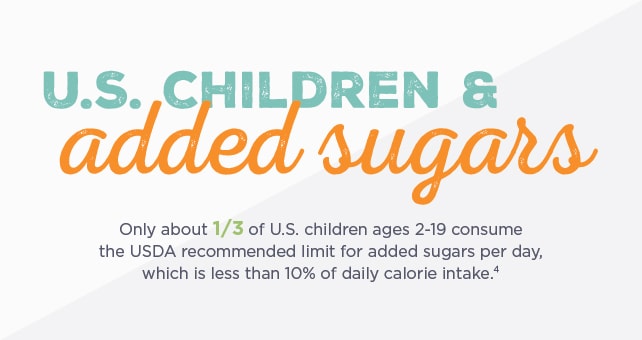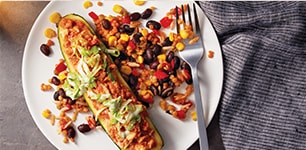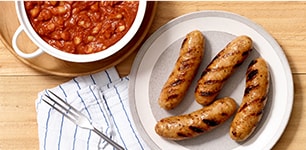Added sugars seem to be everywhere—especially for kids—from drinks, snacks, and cereals to less-obvious places such as ketchup, dressings, and pasta sauce.1 Many American children consume too many added sugars, which may lead to a higher risk of obesity,2 cardiovascular disease,3 and high cholesterol levels. The good news is that there are many easy ways we can help you limit added sugars in your kids’ diets. Let’s start by learning the basics about added sugars and recommended limits.
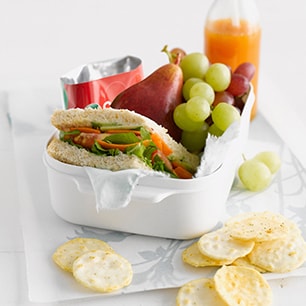
Added Sugars vs. Naturally Occurring Sugars
Added sugars are those that are added during food processing and manufacturing to improve flavor, appearance, or texture. They are an additional source of calories without any nutritional benefits.
Naturally occurring sugars are found in foods that also contain essential nutrients, such as the fiber in fruit or the protein in milk.
Recommended Limits
According to the Dietary Guidelines for Americans 2015–2020, healthy eating patterns limit added sugars to less than 10% of calories per day. This recommendation helps people meet nutrient and food group needs through nutrient-dense food and beverage choices and stay within calorie limits. Unfortunately, the majority of kids consume more added sugars than recommended.
We have some simple strategies and tips for busy parents looking to minimize added sugars in their family’s weekly routine.
- Learn to read labels.
Teach your kids the good habit of reading food labels. On January 1,2020, new FDA food labels were implemented. Among other changes, the new labels list total sugars, added sugars, and percent daily value for added sugars. This will help your family better track intake of added sugars. For items that don’t have the new labels yet, be sure to check the ingredients list for added sugars in disguise. - Make a better choice.
Introduce your child to our Better Choice shelf tags, which identify items that have more of the nutrients you need, like fiber, and less of the things you don’t need, like added sugars. Look for these easy-to-spot green tags and icons right on our shelves when you’re shopping. - Revisit breakfast.
Rather than stocking your pantry with high-sugar cereals, granola, and breakfast bars, try some simple alternatives:- Buy unsweetened cereal and add fresh fruit for sweetness.
- Add a ripe mashed banana to your plain oatmeal and microwave it for a minute.
- Try our Berry Oat Bake recipe, which meets our Better Choice recipe criteria.
- Be smart about sauces.
Though they may not taste sweet, many sauces—such as barbecue sauce, pasta sauce, and ketchup—contain added sugars. Use Better Choice shelf tags to identify options lower in added sugars. Or make your own sauce. Try our Grilled Chicken Sausage & Sweet-Date Barbecue Baked Beans recipe, which includes dates in a barbecue sauce to sweeten baked beans naturally. - Rethink sugary drinks.
Many drinks are high in added sugars. Here are a few ideas for keeping drinks in check:- Look for 100% juice with no added sugars or fruit juice blends made without added sugars, such as GreenWise Organic Juice Pouches.
- Flavor your water naturally with fresh fruit.
- Find more ideas for avoiding drinks with added sugars.
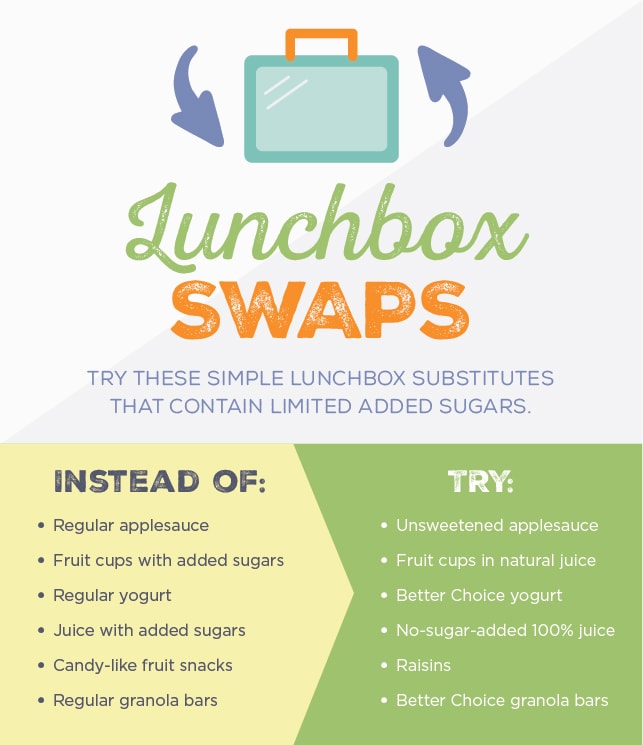
Consider the Big Picture
Remember that all the pieces of a healthy eating pattern fit together like a puzzle to meet nutritional needs without exceeding limits, such as those for added sugars, saturated fats, sodium, and total calories. Be sure to incorporate foods your family enjoys—including treats here and there—while considering the big picture.
For the Love of You
Choosing how you eat is uniquely personal. It’s about your needs, your preferences, and your goals. As your wellness ally, we're in your corner with fresh ideas, recipes, and wellness icons that make it easier to shift toward wiser food choices. It’s all about you, at your very best.
Sources
1 Cording, Jessica, MS, RD, CDN. "Looking to Reduce Your Family's Intake of Added Sugars? Here's How." EatRight.org. December 7, 2016.
2 Sahoo, Krushnapriya, Bishnupriya Sahoo, et al. "Childhood obesity: causes and consequences." U.S. National Library of Medicine. April 2015.
3 Vos, Miriam B., Jill L. Kaar, et al. "Added Sugars and Cardiovascular Disease Risk in Children: A Scientific Statement From the American Heart Association ." American Heart Association. August 22, 2016.
4 Bowman, Shanthy A., PhD, John C. Clemens, MS, et al. "Added Sugars Intake of Americans: What We Eat in America, NHANES 2013-2014." Agricultural Research Service. May 2017.
5 U.S. Department of Health & Human Services (HHS). "Appendix 2. Estimated Calorie Needs per Day, by Age, Sex, and Physical Activity Level." 2015-2020 Dietary Guidelines for Americans, 8th ed. November 21, 2016.

 You are about to leave publix.com and enter the Instacart site that they operate and control. Publix’s delivery and curbside pickup item prices are higher than item prices in physical store locations. Prices are based on data collected in store and are subject to delays and errors. Fees, tips & taxes may apply. Subject to terms & availability. Publix Liquors orders cannot be combined with grocery delivery. Drink Responsibly. Be 21. For prescription delivery, log in to your pharmacy account by using the Publix Pharmacy app or visiting
You are about to leave publix.com and enter the Instacart site that they operate and control. Publix’s delivery and curbside pickup item prices are higher than item prices in physical store locations. Prices are based on data collected in store and are subject to delays and errors. Fees, tips & taxes may apply. Subject to terms & availability. Publix Liquors orders cannot be combined with grocery delivery. Drink Responsibly. Be 21. For prescription delivery, log in to your pharmacy account by using the Publix Pharmacy app or visiting 